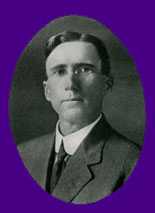
1909
In the first year academic year at the State Normal and Industrial School for Women for Harrisonburg, President Julian A. Burruss expressed his Christmas wish at a morning assembly in December: “I wish Santa Claus would bring us a school song.” Later that month, two songs – “Shendo Land ” and “Blue-Stone Hill” – mysteriously appeared in the president's mailbox. They were originally attributed to the anonymous “Sandy Claws,” but History Professor John Wayland later revealed himself as the author. Early the next year, “Blue-Stone Hill” was selected as the school's official song. It was replaced as the school song by “Alma Mater” in 1931.
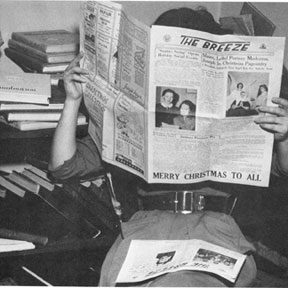
1922
On Saturday, December 2, Professor John Wayland and two students oversaw the production of the first issue of the new student newspaper, The Breeze. There were 400 copies of the newspaper produced. It measured 10.5 by 15 inches and contained no photographs or graphics of any kind. It did have 25 business advertisements within the four-page, four-column newspaper. The Breeze was published every other Saturday and cost 10 cents a copy or $1 for a year's subscription. The Breeze has been the school's student newspaper for more than 80 years and today is produced twice a week and distributed free to students, faculty and staff.
1927
President Samuel P. Duke was notified that the State Teachers College at Harrisonburg had been accepted as an accredited member of the Southern Association of Colleges and Secondary Schools. The organization, now known as the Southern Association of Colleges and Schools, is the primary accrediting agencies for institutions of higher learning. Madison has maintained its accreditation ever since.
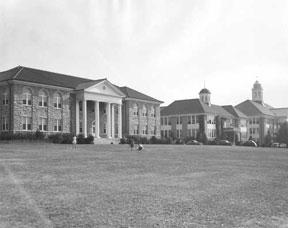
1939
Madison Memorial Library, now named Carrier Library, was formally opened during a two-hour reception on the evening of December 12. The library had opened for use by students in September, two days after classes began. At the reception, visitors were shown displays of historical documents and other items associated with President James Madison as well as a collection of the first books purchased for the school library in 1909.
1941
Japanese planes attacked the U.S. naval fleet anchored at Pearl Harbor, Hawaii, on December 7 and war was declared on Japan the following day. Patriotism and a sense of duty swept across the Madison campus, as had been the case in World War I. The Breeze urged students “to continue with the business of preparing” themselves to take their places in the world but also to be prepared to “be called to the jobs which the men of the nation must vacate, in order to serve in the fighting forces.” In the last days of the fall quarter, which ended on December 20, the school organized a Red Cross first aid class – the first of many war courses.
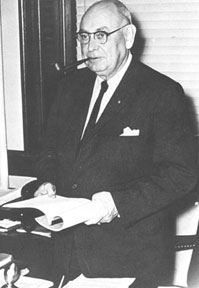
1949
G. Tyler Miller, Madison's third president, became the first president to be formally inaugurated. Miller was inaugurated at an 11 a.m. ceremony on December 10 before a capacity crowd in Wilson Hall Auditorium. Among those in attendance were delegates from 130 universities and colleges and Virginia Governor William H. Tuck. In his inaugural address, Miller called for Madison to become a full coeducational institution and to be able to house men on campus. He also advocated an expansion of the school's graduate program.
1971
In the opening game of the 1971-72 basketball season on December 1, the Madison College Dukes set a still-standing school record for points scored when they defeated Luther Rice College (now University) 146-50. The game against the Georgia school was played in the Harrisonburg High School Gym, where all Madison home games were played until 1972 when Godwin Hall opened. The Dukes were coached by Athletic Director Dean Ehlers. In his first and only season as Madison basketball coach, Ehlers had a 16-7 record.
1983
In its issue of December 1, U.S. News & World Report first ranked JMU among the top academic institutions in the country. U.S. News ranked JMU as the seventh best comprehensive university in the eastern United States – and the highest ranked public school in that category. The magazine's categories have been changed several times but JMU has been included in U.S. News' rankings every year since 1983. JMU has been named the top master's level university in the South 18 years, the past 14 in a row.
1985
On December 20, JMU held its first December Commencement program. President Ronald E. Carrier was the main speaker in the Wilson Hall Auditorium ceremony. Wilson Hall, with a seating capacity of around 1,400, was far from inadequate for the large crowd. Hundreds of unhappy spectators had to be turned away. The following year, the December ceremony was moved to its current location in the JMU Convocation Center
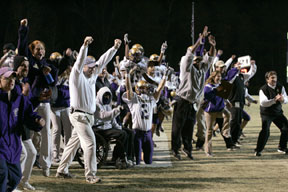
2004
The JMU Dukes became the first (and still only) Division I Virginia football team to win a national championship by defeating the University of Montana 31-21 in Chattanooga, Tennessee. The game concluded a 13-2 record for the Dukes. To reach the title game, JMU had become the first team in NCAA history to win three straight playoff games in the road.
